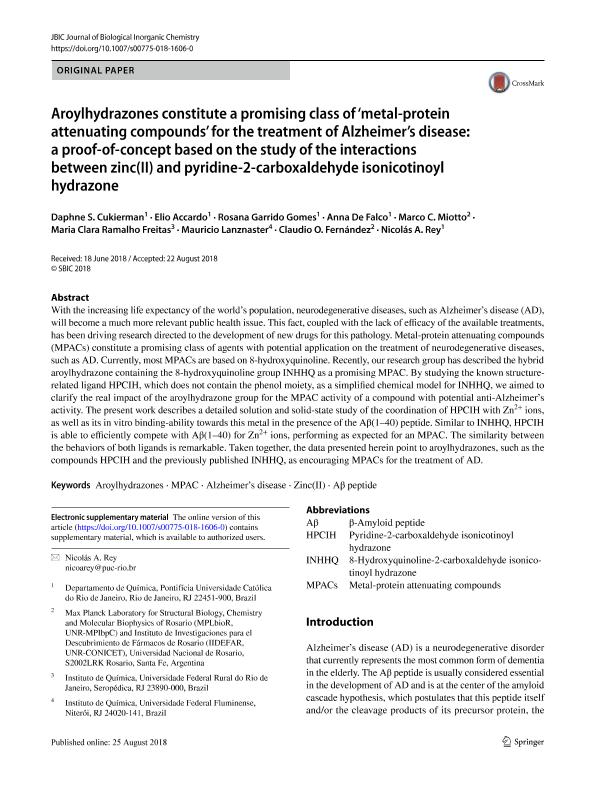Mostrar el registro sencillo del ítem
dc.contributor.author
Cukierman, Daphne S.
dc.contributor.author
Accardo, Elio
dc.contributor.author
Gomes, Rosana Garrido
dc.contributor.author
De Falco, Anna
dc.contributor.author
Miotto, Marco César

dc.contributor.author
Freitas, Maria Clara Ramalho
dc.contributor.author
Lanznaster, Mauricio
dc.contributor.author
Fernandez, Claudio Oscar

dc.contributor.author
Rey, Nicolás A.
dc.date.available
2019-12-20T20:26:04Z
dc.date.issued
2018-12
dc.identifier.citation
Cukierman, Daphne S.; Accardo, Elio; Gomes, Rosana Garrido; De Falco, Anna; Miotto, Marco César; et al.; Aroylhydrazones constitute a promising class of ‘metal-protein attenuating compounds’ for the treatment of Alzheimer’s disease: a proof-of-concept based on the study of the interactions between zinc(II) and pyridine-2-carboxaldehyde isonicotinoyl hydrazone; Springer; Journal of Biological Inorganic Chemistry; 23; 8; 12-2018; 1227-1241
dc.identifier.issn
0949-8257
dc.identifier.uri
http://hdl.handle.net/11336/92673
dc.description.abstract
With the increasing life expectancy of the world’s population, neurodegenerative diseases, such as Alzheimer’s disease (AD), will become a much more relevant public health issue. This fact, coupled with the lack of efficacy of the available treatments, has been driving research directed to the development of new drugs for this pathology. Metal-protein attenuating compounds (MPACs) constitute a promising class of agents with potential application on the treatment of neurodegenerative diseases, such as AD. Currently, most MPACs are based on 8-hydroxyquinoline. Recently, our research group has described the hybrid aroylhydrazone containing the 8-hydroxyquinoline group INHHQ as a promising MPAC. By studying the known structure-related ligand HPCIH, which does not contain the phenol moiety, as a simplified chemical model for INHHQ, we aimed to clarify the real impact of the aroylhydrazone group for the MPAC activity of a compound with potential anti-Alzheimer’s activity. The present work describes a detailed solution and solid-state study of the coordination of HPCIH with Zn2+ ions, as well as its in vitro binding-ability towards this metal in the presence of the Aβ(1–40) peptide. Similar to INHHQ, HPCIH is able to efficiently compete with Aβ(1–40) for Zn2+ ions, performing as expected for an MPAC. The similarity between the behaviors of both ligands is remarkable. Taken together, the data presented herein point to aroylhydrazones, such as the compounds HPCIH and the previously published INHHQ, as encouraging MPACs for the treatment of AD.
dc.format
application/pdf
dc.language.iso
eng
dc.publisher
Springer

dc.rights
info:eu-repo/semantics/openAccess
dc.rights.uri
https://creativecommons.org/licenses/by-nc-sa/2.5/ar/
dc.subject
ALZHEIMER’S DISEASE
dc.subject
AROYLHYDRAZONES
dc.subject
AΒ PEPTIDE
dc.subject
MPAC
dc.subject
ZINC(II)
dc.subject.classification
Química Inorgánica y Nuclear

dc.subject.classification
Ciencias Químicas

dc.subject.classification
CIENCIAS NATURALES Y EXACTAS

dc.title
Aroylhydrazones constitute a promising class of ‘metal-protein attenuating compounds’ for the treatment of Alzheimer’s disease: a proof-of-concept based on the study of the interactions between zinc(II) and pyridine-2-carboxaldehyde isonicotinoyl hydrazone
dc.type
info:eu-repo/semantics/article
dc.type
info:ar-repo/semantics/artículo
dc.type
info:eu-repo/semantics/publishedVersion
dc.date.updated
2019-10-24T18:17:12Z
dc.journal.volume
23
dc.journal.number
8
dc.journal.pagination
1227-1241
dc.journal.pais
Alemania

dc.description.fil
Fil: Cukierman, Daphne S.. Pontifícia Universidade Católica do Rio de Janeiro; Brasil
dc.description.fil
Fil: Accardo, Elio. Pontifícia Universidade Católica do Rio de Janeiro; Brasil
dc.description.fil
Fil: Gomes, Rosana Garrido. Pontifícia Universidade Católica do Rio de Janeiro; Brasil
dc.description.fil
Fil: De Falco, Anna. Pontifícia Universidade Católica do Rio de Janeiro; Brasil
dc.description.fil
Fil: Miotto, Marco César. Universidad Nacional de Rosario; Argentina
dc.description.fil
Fil: Freitas, Maria Clara Ramalho. Universidade Federal do Rio de Janeiro; Brasil
dc.description.fil
Fil: Lanznaster, Mauricio. Universidade Federal Fluminense; Brasil
dc.description.fil
Fil: Fernández, Claudio O.. Universidad Nacional de Rosario; Argentina
dc.description.fil
Fil: Rey, Nicolás A.. Pontifícia Universidade Católica do Rio de Janeiro; Brasil
dc.journal.title
Journal of Biological Inorganic Chemistry

dc.relation.alternativeid
info:eu-repo/semantics/altIdentifier/doi/http://dx.doi.org/10.1007/s00775-018-1606-0
Archivos asociados
